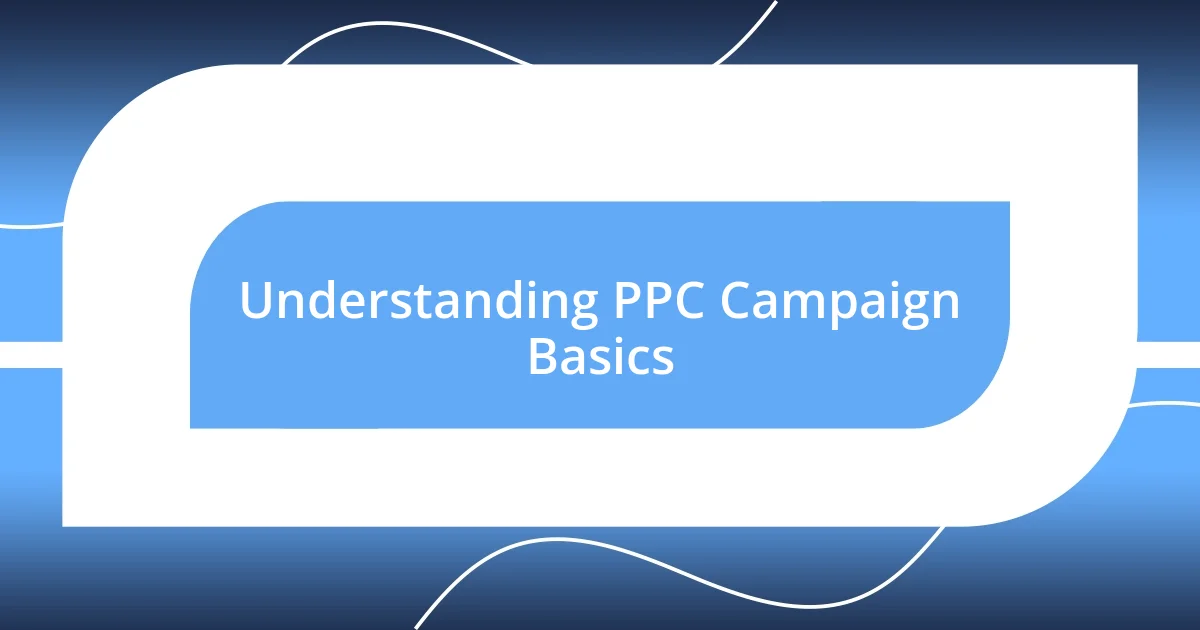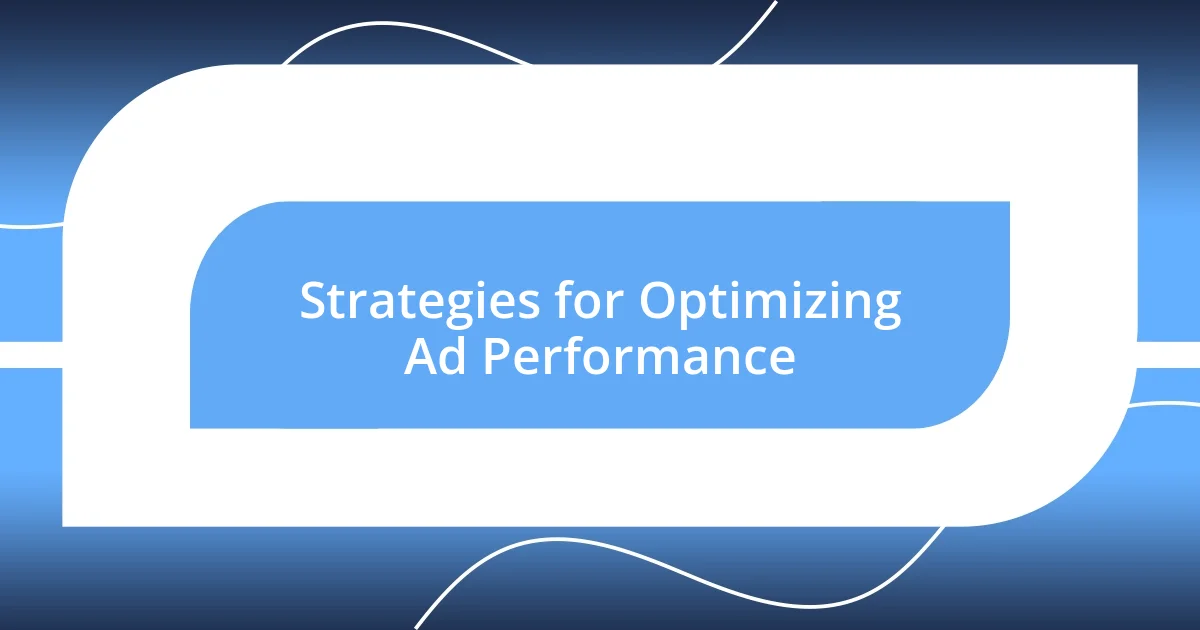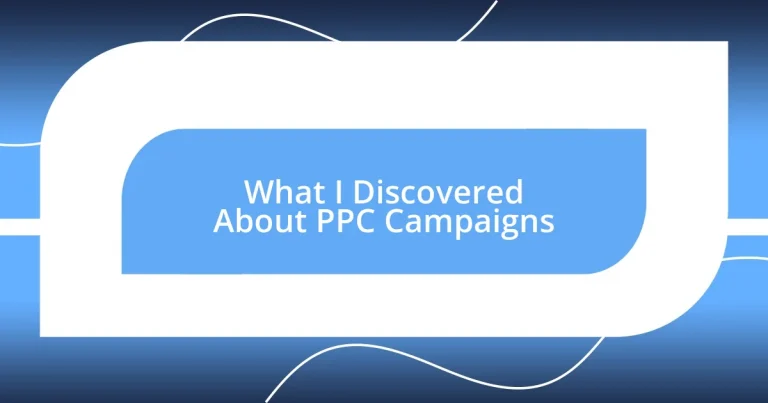Key takeaways:
- PPC campaigns require a clear understanding of goals and target audience to convert clicks into meaningful engagement.
- Effective keyword research using tools and customer feedback can significantly enhance campaign performance and lead quality.
- Regular analysis of campaign results and metrics, such as ROAS and conversion rates, provides critical insights for optimizing strategies and improving future campaigns.

Understanding PPC Campaign Basics
PPC, or Pay-Per-Click, is a digital advertising model where advertisers pay a fee each time their ad is clicked. I remember the first time I dipped my toes into PPC; I was both excited and anxious about investing money into something I wasn’t fully confident about. It feels like placing a bet—a thrilling gamble that can yield fantastic returns or leave you wondering where it all went wrong.
One key aspect to grasp is that PPC isn’t just about paying for clicks; it’s about targeting those clicks effectively. Have you ever experienced a flood of traffic to your site yet noticed little conversion? I have, and it was a real eye-opener. It taught me that understanding your audience and what keywords they use is crucial for creating ads that not only entice clicks but also lead to meaningful engagement.
Moreover, the budgeting element of PPC campaigns can be a game changer. When I first set my budget, I thought I understood the financial commitment it required—but it took some trial and error to find the sweet spot. How often have you felt your budget slip away without a trace? I know that sensation, and it underscored the importance of constant monitoring and adjusting of my campaigns for the best results. It’s all about refining your strategy to ensure you’re getting the most bang for your buck.

How to Set Campaign Goals
Setting clear campaign goals is essential for any PPC campaign. I recall when I first crafted my goals; I was overwhelmed by the options. Was I aiming for brand awareness, lead generation, or something else? Defining specific, measurable objectives transformed my approach. They became my guiding star, helping me keep focused and truly assess my campaign’s success.
When I began my first campaign, I noticed a significant difference in results after honing in on my goals. For instance, instead of an ambiguous “increase traffic,” I defined the goal as “increase traffic by 30% in three months.” This specificity allowed me to track performance effectively and adjust strategies in real time. How often do we aim for broad targets and end up feeling frustrated? Zeroing in on precise goals made my efforts feel directed and purposeful.
Lastly, aligning goals with overall business objectives is crucial for success. I remember realizing that personal metrics needed to dovetail with the company’s broader vision. For example, while conversion should be a priority, understanding how it impacts customer lifetime value gave deeper meaning to my PPC success. Differentiate between short and long-term goals to cultivate a comprehensive strategy that benefits not just the campaign but the entire business.
| Goal Type | Description |
|---|---|
| Brand Awareness | Focus on attracting new visitors and increasing visibility. |
| Lead Generation | Targets actions that generate leads, like sign-ups or inquiries. |
| Sales | Aims to directly increase sales or conversions from ads. |

Techniques for Effective Keyword Research
When it comes to keyword research, I’ve discovered that the right techniques can make all the difference. Initially, I relied heavily on my instincts—using words that I thought were relevant. But it wasn’t until I started utilizing tools like Google Keyword Planner that I truly understood the breadth of options available. Seeing actual search volumes made me realize how many gems were out there, waiting to be discovered.
Here are some techniques that I found particularly effective for keyword research:
- Use Keyword Tools: Platforms like SEMrush or Ahrefs provide insights into search volume, competition, and related keywords.
- Analyze Competitors: I often take a peek at what keywords my competitors are ranking for. This strategy opened my eyes to opportunities I had previously overlooked.
- Leverage Long-Tail Keywords: While short keywords can attract a lot of traffic, I’ve found that long-tail keywords lead to more qualified leads. Phrases like “best running shoes for flat feet” are specific and often convert better.
- Utilize Google Trends: Monitoring trends helped me stay ahead of the curve, especially during seasonal shifts. I remember adopting trending keywords for holiday campaigns, which significantly boosted my visibility.
- Engage with Customer Feedback: Listening to what my audience says can inspire keyword ideas. When customers mentioned specific problems, I included those terms in my campaigns, making my ads feel more relevant and relatable.
By combining these techniques, I’ve often found myself strengthening my keyword strategy and ultimately improving campaign performance. It’s about being proactive and adapting to what resonates with my audience.

Strategies for Optimizing Ad Performance
Optimizing ad performance is a multifaceted challenge that I’ve navigated through trial and error. One strategy that stood out for me is A/B testing, which allows you to experiment with different elements of your ads like headlines and images. I remember feeling the excitement—and anxiety—when I first launched a split test for my ad copies. Seeing how one small change could lead to a remarkable increase in click-through rates was a revelation. Doesn’t it feel empowering to have data-backed insights at your fingertips?
Another important strategy I’ve embraced is refining target audiences. Initially, I made the mistake of casting a wide net, hoping to capture as many clicks as possible. But over time, I realized that narrowing my focus led to better engagement. For instance, when I started segmenting my audience based on their behavior and interests, my conversion rates skyrocketed. It was like tuning a guitar—once I found the right pitch, everything began to resonate beautifully. How much time do we waste on broad targeting without realizing the true value of specificity?
Lastly, I can’t stress enough the power of optimizing ad scheduling. I still remember the day I decided to analyze when my audience was most active. Adjusting my ad appearances to peak times not only improved visibility but also reduced costs. It felt like flipping a switch and watching the lights come on. When did you last evaluate the timing of your ads? If you haven’t, give it a try; the results might surprise you!

Analyzing PPC Campaign Results
Analyzing PPC campaign results is where the real learning happens. I often find myself diving into metrics, eagerly searching for insights that could propel the next campaign. For instance, the first time I sifted through click-through rates (CTR) versus conversion rates, it felt like uncovering hidden treasures. I remember that moment of realization—understanding that a high CTR didn’t always equal success. It made me think: What’s the ultimate goal of the campaign? That question has guided many of my analysis sessions since then.
When I explore the performance reports, I prioritize metrics that align with my objectives. For example, return on ad spend (ROAS) has become a focal point for me. I once ran an e-commerce campaign where the ROAS revealed that some keywords were costing more than they were returning. That experience bolstered my belief in scrutinizing every penny spent. It’s like being a detective, piecing together the story of how each dollar contributes to the bottom line—what a thrill that is! How often do we let emotions drive our decisions without checking the numbers first?
At the end of the day, presenting these findings to my team often feels like sharing a riveting story. I can see their eyes light up when I highlight changes that could improve performance. Recently, I shared how optimizing landing pages based on user behavior led to a 30% increase in conversions. It was a proud moment! Reflecting on these results not only informs my future strategies but also instills confidence in my team. I challenge you—what stories do your results tell? Engaging with data can unveil a narrative that could transform the direction of your campaigns.













